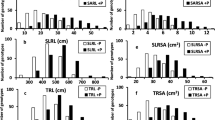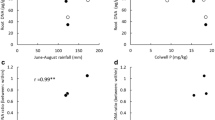Abstract
The selection and breeding of crop genotypes with root traits that improve soil resource extraction is a promising avenue to improved nutrient and water use efficiency in low-input farming systems. Such genotypes may accelerate nutrient extraction (“nutrient mining”), but may also reduce nutrient loss via soil erosion by producing greater shoot biomass and by direct effects of root traits on aggregate formation and water infiltration. Little is known about the effects of root architecture on phosphorus (P) runoff and soil erosion, and the relative importance of root and shoot traits on runoff P loss has not been determined. Four genotypes of common bean (Phaseolus vulgaris L.) and two genotypes of soybean (Glycine max) selected for contrasting root architecture were grown in a low P soil (Aquic Fragiudult, <20 mg kg−1 Mehlich-3 P, 3% slope) and subjected to rainfall-runoff experiments with and without shoot removal. Plots with intact shoots had significantly lower runoff volumes (1.3–7.6 mm) and total P loads in runoff (0.005–0.32 kg ha−1) than plots with shoots removed (7.0–16.8 mm; 0.025–1.95 kg ha−1). Dissolved reactive P leached from plant material did not contribute significantly to P loss in runoff. Total root length acquired from soil cores differed significantly among genotypes. Root length densities in the upper 15 cm of soil mid-way between rows were less than 4.0 cm cm−3 and variation in root length density was not correlated with runoff or P loss. Root length density also did not affect rainfall infiltration or surface runoff volume. We conclude that for annual dicotyledonous crops such as bean and soybean with relatively low root length densities, root traits have little direct effect on soil erosion.






Similar content being viewed by others
Notes
Mention of trade names does not indicate endorsement by the US Department of Agriculture.
References
Barley KP (1954) Effects of root growth and decay on the permeability of a synthetic sandy loam. Soil Sci 78:205–210 doi:10.1097/00010694-195409000-00005
Bates TR, Lynch JP (2001) Root hairs confer a competitive advantage under low phosphorus availability. Plant Soil 236:243–250 doi:10.1023/A:1012791706800
Bechmann ME, Kleinman PJA, Sharpley AN, Saporito LS (2005) Freeze–thaw effects on phosphorus loss in runoff froin manured and catch-cropped soils. J Environ Qual 34:2301–2309 doi:10.2134/jeq2004.0415
Beegle DB (2007) Soil fertility management. In: Penn State Agronomy Guide, 2007-2008. University Park, Pennsylvania, USA
Bolster CH (2 007) A method for fitting the nonlinear Langmuir equation to soil sorption data using Microsoft Excel. Available at http://ars.usda.gov/msa/awmru/bolster/Sorption_spreadsheets (verified 29 May 2008)
Bonser AM, Lynch J, Snapp S (1996) Effect of phosphorus deficiency on growth angle of basal roots of Phaseolus vulgaris L. New Phytol 132:281–288 doi:10.1111/j.1469-8137.1996.tb01847.x
Bradford JM, Ferris JE, Remley PA (1987) Interrill soil erosion processes: I. Effect of surface sealing on infiltration, runoff, and soil splash detachment. Soil Sci Soc Am J 51:1566–1571
Bui EN, Box JE Jr (1993) Growing corn root effects on interrill soil erosion. Soil Sci Soc Am J 57:1066–1070
Cox MS, Gerard PD, Wardlaw MC, Abshire MJ (2003) Variability of selected soil properties and their relationships with soybean yield. Soil Sci Soc Am J 67:1296–1302
De Baets S, Poesen J, Gyssels G, Knapen A (2006) Effects of grass roots on the erodibility of topsoils during concentrated flow. Geomorphology 76:54–67 doi:10.1016/j.geomorph.2005.10.002
De Baets S, Poesen J, Knapen A, Galindo P (2007) Impact of root architecture on the erosion-reducing potential of roots during concentrated flow. Earth Surf Process Land 32:1323–1345 doi:10.1002/esp.1470
Di Virgilio N, Monti A, Venturi G (2006) Spatial variability of switchgrass (Panicum virgatum, L.) yield as related to soil parameters in a small field. Field Crops Res 101:232–239 doi:10.1016/j.fcr.2006.11.009
Dunbabin VM, Diggle AJ, Rengel Z, van Hugten R (2002) Modelling the interactions between water and nutrient uptake and root growth. Plant Soil 239:19–38 doi:10.1023/A:1014939512104
Eckert D, Sims JT (1995) Recommended soil pH and lime requirement tests. In: Sims JT, Wolf A (eds) Recommended soil testing procedures for the Northeastern United States. Northeast Regional Bulletin #493. Agricultural Experiment Station, University of Delaware, Newark, DE, pp 11–16
Engel FL, Bertol I, Mafra AL, Cogo NP (2007) Water erosion under simulated rainfall in different soil management systems during soybean growth. Sci Agric 64:187–193 doi:10.1590/S0103-90162007000200013
Fairhurst T, Lefroy R, Mutert E, Batjes NH (1999) The importance, distribution and causes of P deficiency as a constraint to crop production in the tropics. Agroforest Forum 9:2–8
Flanagan DC, Nearing MA (1995) USDA-Water Erosion Prediction Project (WEPP), hillslope profile and watershed model documentation. West Lafayette, In: US Department of Agriculture-Agricultural Research Service, National Erosion Research Laboratory Report 10
Foot K, Morgan RPC (2005) The role of leaf inclination, leaf orientation and plant canopy architecture in soil particle detachment by raindrops. Earth Surf Process Land 30:1509–1520 doi:10.1002/esp.1207
França MGC, This ATP, Pimentel C, Rossiello ROP, Zuily-Fodil Y, Laffray D (2000) Differences in growth and water relations among Phaseolus vulgaris cultivars in response to induced drought stress. Environ Exp Bot 43:227–237 doi:10.1016/S0098-8472(99)00060-X
Ghidey F, Alberts EE (1997) Plant root effects on soil erodibility, splash detachment, soil strength, and aggregate stability. Trans Am Soc Agric Eng 40:129–135
Gyssels G, Poesen J (2003) The importance of root characteristics in controlling concentrated flow erosion rates. Earth Surf Process Land 28:371–384 doi:10.1002/esp.447
Gyssels G, Poeson J, Bochet E, Li Y (2005) Impact of plant roots on the resistance of soils to erosion by water: a review. Prog Phys Geogr 29:189–217 doi:10.1191/0309133305pp443ra
Hallet PD, Gordon DC, Bengough AG (2003) Plant influence on rhizosphere hydraulic properties: direct measurements using a miniaturized infiltrometer. New Phytol 157:597–603 doi:10.1046/j.1469-8137.2003.00690.x
Ho MD, Rosas JC, Brown KM, Lynch JP (2005) Root architectural tradeoffs for water and phosphorus acquisition in heterogeneous environments. Funct Plant Biol 32:737–748 doi:10.1071/FP05043
Humphry JB, Daniel TC, Edwards DR, Sharpley AN (2002) A portable rainfall simulator for plot-scale runoff studies. Appl Eng Agric 18:199–204
Klassen SP, Ritchie G, Frantz JM, Pinnock D, Bugbee B (2003) Real-time imaging of ground cover: relationships with radiation capture, canopy photosynthesis, and daily growth rate. Chapter 1: pp 3–14. In: Digital Imaging and Spectral Techniques: Applications to Precision Agriculture and Crop Physiology. Am Soc Agron Special Publication No. 66. Madison, WI
Kleinman PJA, Salon P, Sharpley AN, Saporito LS (2005) Effect of cover crops established at time of corn planting on phosphorus runoff from soils before and after dairy manure application. J Soil Water Conserv 60:311–321
Larson WE, Pierce FJ, Dowdy RH (1983) The threat of soil erosion to long-term crop productivity. Science 219:458–465 doi:10.1126/science.219.4584.458
Lynch JP (2007) Roots of the second green revolution. Aust J Bot 55:493–512 doi:10.1071/BT06118
Lynch JP, Brown KM (2001) Topsoil foraging—an architectural adaptation of plants to low phosphorus availability. Plant Soil 237:225–237 doi:10.1023/A:1013324727040
Mamo M, Bubenzer GD (2001a) Detachment rate, soil erodibility, and soil strength as influenced by living plants roots Part II: Field study. Trans Am Soc Agric Eng 44:1175–1181
Mamo M, Bubenzer GD (2001b) Detachment rate, soil erodibility, and soil strength as influenced by living plants roots Part I: Laboratory Study. Trans Am Soc Agric Eng 44:1175–1181
Marschner H (1995) Mineral Nutrition of Higher Plants. Academic Press, San Diego
Mehlich A (1984) Mehlich 3 soil test extractant: a modification of Mehlich 2 extractant. Commun Soil Sci Plant Anal 15:1409–1416
Meyer LD, Mannering JV (1971) The influence of vegetation and vegetative mulches on soil erosion. In: Biological effects in the hydrological cycle. Proceedings of the Third International Seminar for Hydrology Professors: a National Science Foundation Advanced Science Seminar held at Purdue University West Lafayette, Indiana, U.S.A. July 18–30, 1971
Miguel M (2004) Genotypic variation in root hairs and phosphorus efficiency in common bean (Phaseolus vulgaris L). MS Thesis, Penn State, University Park, PA
Miller CR, Ochoa I, Nielsen K, Beck D, Lynch JP (2003) Genetic variation for adventitious rooting in response to low phosphorus availability: potential utility for phosphorus acquisition from stratified soils. Funct Plant Biol 30:973–985 doi:10.1071/FP03078
Murphy J, Riley JP (1962) A modified single solution method for the determination of phosphorus in natural waters. Anal Chim Acta 27:31–36 doi:10.1016/S0003-2670(00)88444-5
Nair PS, Logan TJ, Sharpley AN, Sommers LE, Tabatabai M, Yuan TL (1984) Interlaboratory comparison of a standardized phosphorus adsorption procedure. J Environ Qual 13:591–595
Natural Resource Conservation Service (2006) Land Resource Regions and Major Land Use Areas of the United States, the Caribbean, and the Pacific Basin. US Department of Agriculture, Agriculture Handbook No. 296
Pote DH, Daniel TC (2000) Analyzing for total phosphorus and total dissolved phosphorus in water samples. In: Methods of Phosphorus Analysis for Soils, Sediments, Residuals, and Waters. Southern Cooperative Series Bulletin #396 (G.M. Pierzynski, Ed.)
Pukacki PM, Kendall EJ, McKersie BD (1991) Membrane injury during freezing stress to winter wheat (Triticum aestivum L.) crowns. J Plant Physiol 138:516–521
Reid JB, Goss MJ (1981) Effect of living roots of different plant species on the aggregate stability of two arable soils. J Soil Sci 32:521–541 doi:10.1111/j.1365-2389.1981.tb01727.x
Renard KG, Foster GR, Weesies GA, McCool DK, Yoder DC (1997) Predicting Soil Erosion by Water: A Guide to Conservation Planning with the Revised Universal Soil Loss Equation (RUSLE). US Department of Agriculture, Agriculture Handbook No. 703
Roberson T, Bundy LG, Andraski TW (2007) Freezing and drying effects on potential plant contributions to phosphorus in runoff. J Environ Qual 36:532–539 doi:10.2134/jeq2006.0169
Ross D (1995) Recommended soil tests for determining soil cation exchange capacity. p. 62–69. In Sims JT, Wolf, A (eds) Recommended soil testing procedures for the Northeastern United States. Northeast Regional Bulletin #493. Agricultural Experiment Station, University of Delaware, Newark, DE
Sharpley AN (1981) The contribution of phosphorus leached from crop canopy to losses in surface runoff. J Environ Qual 10:160–165
Sharpley AN, Menzel RG, Smith SJ, Rhoades ED, Olness AE (1981) The sorption of soluble phosphorus by soil material during transport in runoff from cropped and grassed watersheds. J Environ Qual 10:211–215
Sharpley AN, McDowell RW, Weld JL, Kleinman PJA (2001) Assessing site vulnerability to phosphorus loss in an agricultural watershed. J Environ Qual 30:2026–2036
Somma F, Hopmans JW, Clausnitzer V (1998) Transient three-dimensional modeling of soil water and solute transport with simultaneous root growth, root water and nutrient uptake. Plant Soil 202:281–293 doi:10.1023/A:1004378602378
SPSS for Mac, Version 11.0.4. 2005. Chicago: SPSS Inc
Whalley WR, Leeds-Harrison PB, Leech PK, Risely B, Bird NRA (2004) The hydraulic properties of soil at root–soil interface. Soil Sci 169:90–99
Young IM (1998) Biophysical interactions at the root–soil interface: a review. J Agr Sci 130:1–7
Zhao J, Fu JB, Liao H, He Y, Nian H, Hu YM, Qiu LJ, Dong YS, Yan X (2004) Characterization of root architecture in an applied core collection for phosphorus efficiency of soybean germplasm. Chin Sci Bull 49:1611–1620
Zhou ZC, Shangguan ZP (2007) The effects of ryegrass roots and shoots on loess erosion under simulated rainfall. Catena 70:350–355
Zhu J, Kaeppler SM, Lynch JP (2005) Mapping of QTL for lateral root branching and length in maize (Zea mays L.) under differential phosphorus supply. Theor Appl Genet 111:688–695
Zhu JM, Kaeppler SM, Lynch JP (2005b) Topsoil foraging and phosphorus acquisition efficiency in maize (Zea mays). Funct Plant Biol 32:749–762
Acknowledgments
We greatly appreciate the advice and assistance of Barton Moyer and Lou Saporito of the USDA-ARS. We thank Dr. Xiaolong Yan of the South China Agricultural University for the soybean seed used in 2005. Ronald Shuey and Bob Oberheim of Pennsylvania State University helped with field preparation. Galen Lynch and Noel Duarte provided help with rainfall simulations. This work was supported by the USAID Bean-Cowpea CRSP, the McKnight Foundation CCRP and the Huck Institute for Life Science.
Author information
Authors and Affiliations
Corresponding author
Additional information
Responsible Editor: N. Jim Barrow.
Rights and permissions
About this article
Cite this article
Henry, A., Kleinman, P.J.A. & Lynch, J.P. Phosphorus runoff from a phosphorus deficient soil under common bean (Phaseolus vulgaris L.) and soybean (Glycine max L.) genotypes with contrasting root architecture. Plant Soil 317, 1–16 (2009). https://doi.org/10.1007/s11104-008-9784-0
Received:
Accepted:
Published:
Issue Date:
DOI: https://doi.org/10.1007/s11104-008-9784-0




